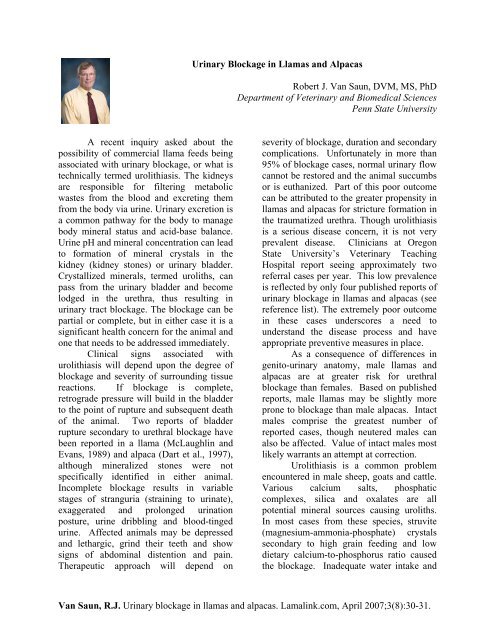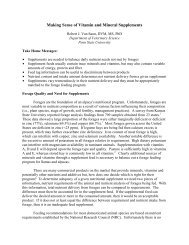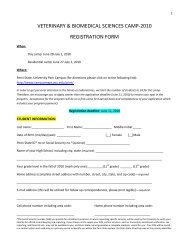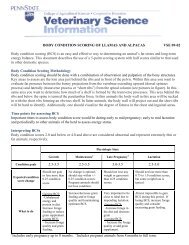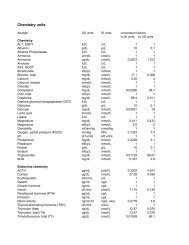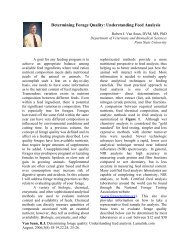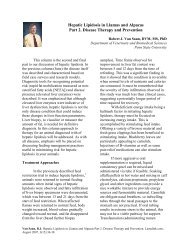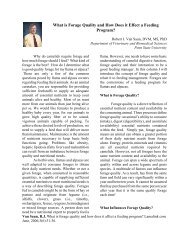Urinary Blockage in Llamas and Alpacas - Veterinary and ...
Urinary Blockage in Llamas and Alpacas - Veterinary and ...
Urinary Blockage in Llamas and Alpacas - Veterinary and ...
Create successful ePaper yourself
Turn your PDF publications into a flip-book with our unique Google optimized e-Paper software.
A recent <strong>in</strong>quiry asked about the<br />
possibility of commercial llama feeds be<strong>in</strong>g<br />
associated with ur<strong>in</strong>ary blockage, or what is<br />
technically termed urolithiasis. The kidneys<br />
are responsible for filter<strong>in</strong>g metabolic<br />
wastes from the blood <strong>and</strong> excret<strong>in</strong>g them<br />
from the body via ur<strong>in</strong>e. <strong>Ur<strong>in</strong>ary</strong> excretion is<br />
a common pathway for the body to manage<br />
body m<strong>in</strong>eral status <strong>and</strong> acid-base balance.<br />
Ur<strong>in</strong>e pH <strong>and</strong> m<strong>in</strong>eral concentration can lead<br />
to formation of m<strong>in</strong>eral crystals <strong>in</strong> the<br />
kidney (kidney stones) or ur<strong>in</strong>ary bladder.<br />
Crystallized m<strong>in</strong>erals, termed uroliths, can<br />
pass from the ur<strong>in</strong>ary bladder <strong>and</strong> become<br />
lodged <strong>in</strong> the urethra, thus result<strong>in</strong>g <strong>in</strong><br />
ur<strong>in</strong>ary tract blockage. The blockage can be<br />
partial or complete, but <strong>in</strong> either case it is a<br />
significant health concern for the animal <strong>and</strong><br />
one that needs to be addressed immediately.<br />
Cl<strong>in</strong>ical signs associated with<br />
urolithiasis will depend upon the degree of<br />
blockage <strong>and</strong> severity of surround<strong>in</strong>g tissue<br />
reactions. If blockage is complete,<br />
retrograde pressure will build <strong>in</strong> the bladder<br />
to the po<strong>in</strong>t of rupture <strong>and</strong> subsequent death<br />
of the animal. Two reports of bladder<br />
rupture secondary to urethral blockage have<br />
been reported <strong>in</strong> a llama (McLaughl<strong>in</strong> <strong>and</strong><br />
Evans, 1989) <strong>and</strong> alpaca (Dart et al., 1997),<br />
although m<strong>in</strong>eralized stones were not<br />
specifically identified <strong>in</strong> either animal.<br />
Incomplete blockage results <strong>in</strong> variable<br />
stages of stranguria (stra<strong>in</strong><strong>in</strong>g to ur<strong>in</strong>ate),<br />
exaggerated <strong>and</strong> prolonged ur<strong>in</strong>ation<br />
posture, ur<strong>in</strong>e dribbl<strong>in</strong>g <strong>and</strong> blood-t<strong>in</strong>ged<br />
ur<strong>in</strong>e. Affected animals may be depressed<br />
<strong>and</strong> lethargic, gr<strong>in</strong>d their teeth <strong>and</strong> show<br />
signs of abdom<strong>in</strong>al distention <strong>and</strong> pa<strong>in</strong>.<br />
Therapeutic approach will depend on<br />
<strong>Ur<strong>in</strong>ary</strong> <strong>Blockage</strong> <strong>in</strong> <strong>Llamas</strong> <strong>and</strong> <strong>Alpacas</strong><br />
Robert J. Van Saun, DVM, MS, PhD<br />
Department of Veter<strong>in</strong>ary <strong>and</strong> Biomedical Sciences<br />
Penn State University<br />
severity of blockage, duration <strong>and</strong> secondary<br />
complications. Unfortunately <strong>in</strong> more than<br />
95% of blockage cases, normal ur<strong>in</strong>ary flow<br />
cannot be restored <strong>and</strong> the animal succumbs<br />
or is euthanized. Part of this poor outcome<br />
can be attributed to the greater propensity <strong>in</strong><br />
llamas <strong>and</strong> alpacas for stricture formation <strong>in</strong><br />
the traumatized urethra. Though urolithiasis<br />
is a serious disease concern, it is not very<br />
prevalent disease. Cl<strong>in</strong>icians at Oregon<br />
State University’s Veter<strong>in</strong>ary Teach<strong>in</strong>g<br />
Hospital report see<strong>in</strong>g approximately two<br />
referral cases per year. This low prevalence<br />
is reflected by only four published reports of<br />
ur<strong>in</strong>ary blockage <strong>in</strong> llamas <strong>and</strong> alpacas (see<br />
reference list). The extremely poor outcome<br />
<strong>in</strong> these cases underscores a need to<br />
underst<strong>and</strong> the disease process <strong>and</strong> have<br />
appropriate preventive measures <strong>in</strong> place.<br />
As a consequence of differences <strong>in</strong><br />
genito-ur<strong>in</strong>ary anatomy, male llamas <strong>and</strong><br />
alpacas are at greater risk for urethral<br />
blockage than females. Based on published<br />
reports, male llamas may be slightly more<br />
prone to blockage than male alpacas. Intact<br />
males comprise the greatest number of<br />
reported cases, though neutered males can<br />
also be affected. Value of <strong>in</strong>tact males most<br />
likely warrants an attempt at correction.<br />
Urolithiasis is a common problem<br />
encountered <strong>in</strong> male sheep, goats <strong>and</strong> cattle.<br />
Various calcium salts, phosphatic<br />
complexes, silica <strong>and</strong> oxalates are all<br />
potential m<strong>in</strong>eral sources caus<strong>in</strong>g uroliths.<br />
In most cases from these species, struvite<br />
(magnesium-ammonia-phosphate) crystals<br />
secondary to high gra<strong>in</strong> feed<strong>in</strong>g <strong>and</strong> low<br />
dietary calcium-to-phosphorus ratio caused<br />
the blockage. Inadequate water <strong>in</strong>take <strong>and</strong><br />
Van Saun, R.J. <strong>Ur<strong>in</strong>ary</strong> blockage <strong>in</strong> llamas <strong>and</strong> alpacas. Lamal<strong>in</strong>k.com, April 2007;3(8):30-31.
vitam<strong>in</strong> A deficiency have been implicated<br />
<strong>in</strong> predispos<strong>in</strong>g to urolithiasis. Reduced<br />
water <strong>in</strong>take can result <strong>in</strong> decreased flush<strong>in</strong>g<br />
action <strong>in</strong> the kidney tubules <strong>and</strong> <strong>in</strong>duce<br />
supersaturation of soluble m<strong>in</strong>erals thus<br />
caus<strong>in</strong>g their precipitation. Vitam<strong>in</strong> A<br />
deficiency can result <strong>in</strong> changes to the<br />
epithelial cells of the ur<strong>in</strong>ary tract <strong>and</strong> cause<br />
slough<strong>in</strong>g of cells becom<strong>in</strong>g a nidus for<br />
m<strong>in</strong>eral crystallization. Alkal<strong>in</strong>e ur<strong>in</strong>ary pH,<br />
often result<strong>in</strong>g from consumption of plants<br />
high <strong>in</strong> potassium, is associated with<br />
formation of calcium phosphate <strong>and</strong> struvite<br />
uroliths. Slightly acidic to neutral ur<strong>in</strong>ary<br />
pH is associated with silicate <strong>and</strong> calcium<br />
oxalate uroliths. Although not a common<br />
disorder <strong>in</strong> llamas <strong>and</strong> alpacas, silicate <strong>and</strong><br />
struvite crystals have been reported (Kock<br />
<strong>and</strong> Fowler, 1982; K<strong>in</strong>gston <strong>and</strong> Stäempfli,<br />
1995).<br />
Little is known about how<br />
urolithiasis occurs <strong>in</strong> llamas <strong>and</strong> alpacas <strong>and</strong><br />
it is assumed that the disease process is<br />
similar to other rum<strong>in</strong>ants. <strong>Llamas</strong> are noted<br />
for hav<strong>in</strong>g lower water <strong>in</strong>take per unit of<br />
metabolic body size <strong>and</strong> lower ur<strong>in</strong>ary<br />
output, which may naturally predispose<br />
them to ur<strong>in</strong>ary calculi. Other potential<br />
predispos<strong>in</strong>g factors <strong>in</strong>clude high alfalfa<br />
feed<strong>in</strong>g, excessive gra<strong>in</strong> <strong>in</strong>take <strong>and</strong><br />
<strong>in</strong>appropriate dietary calcium to phosphorus<br />
ratio. Alfalfa conta<strong>in</strong>s soluble oxalates <strong>and</strong><br />
high concentration of calcium. Excessive<br />
gra<strong>in</strong> feed<strong>in</strong>g can result <strong>in</strong> low dietary<br />
calcium to phosphorus ratio. A number of<br />
weedy or browse plants (Rumex spp., sorrels<br />
<strong>and</strong> dock) conta<strong>in</strong> large amounts of soluble<br />
oxalates that when consumed <strong>in</strong> excess<br />
under the right conditions may result <strong>in</strong><br />
oxalate urolith formation. Mature range<br />
grasses may conta<strong>in</strong> large amounts of<br />
oxalates <strong>and</strong> silicates, which can potentially<br />
contribute to urolith formation. One can<br />
measure acid <strong>in</strong>soluble ash content <strong>in</strong> an<br />
effort to estimate silica content of forages.<br />
Based on these observations, there does not<br />
seem to be any significant factor <strong>in</strong><br />
commercial llama feeds that would suggest<br />
they predispose consum<strong>in</strong>g animals to<br />
urolithiasis. This is not to say that<br />
<strong>in</strong>appropriate consumption of some<br />
commercial products may result <strong>in</strong> altered<br />
dietary nutrient content consistent with some<br />
of the predispos<strong>in</strong>g factors identified.<br />
Nutritional alterations are the<br />
primary concern <strong>and</strong> focus of prevention.<br />
Goals of a dietary prevention program are to<br />
<strong>in</strong>crease water consumption with addition of<br />
salt to the diet <strong>and</strong> ma<strong>in</strong>ta<strong>in</strong> appropriate<br />
amounts of calcium <strong>and</strong> phosphorus <strong>in</strong> the<br />
diet with a calcium-to-phosphorus ratio<br />
between 2-to-4:1. On the other h<strong>and</strong>,<br />
excessive calcium <strong>in</strong>take should be avoided.<br />
Excessive vitam<strong>in</strong> D <strong>in</strong>take could potentially<br />
lead to hypercalcemia or hypercalcuria <strong>and</strong><br />
predispose to calcium urolith formation.<br />
Excessive supplementation of prote<strong>in</strong> <strong>and</strong><br />
magnesium should also be avoided. These<br />
po<strong>in</strong>ts emphasize the need to provide a<br />
properly balanced diet, but no nutrient <strong>in</strong><br />
excess. This challenges us to better<br />
characterize actual nutrient requirements for<br />
llamas <strong>and</strong> alpacas. A new National<br />
Research Council (NRC) report has been<br />
recently published describ<strong>in</strong>g nutrient<br />
requirements for llamas <strong>and</strong> alpacas, but that<br />
is a topic for another column.<br />
Struvite crystals can be prevented by<br />
dietary modification to <strong>in</strong>duce ur<strong>in</strong>e<br />
acidification <strong>in</strong> dogs, cats, sheep <strong>and</strong> goats.<br />
Traditionally, dietary supplementation (5-10<br />
g/kg of dry matter) of ammonium chloride<br />
has been used. More palatable commercial<br />
products capable of acidification are<br />
available as they are commonly used <strong>in</strong><br />
dairy cattle rations prior to calv<strong>in</strong>g to<br />
prevent milk fever. However, little data are<br />
available to validate the efficacy <strong>and</strong> safety<br />
of prolonged feed<strong>in</strong>g of such products to<br />
llamas <strong>and</strong> alpacas. Given the predilection<br />
for oxalate <strong>and</strong> silicate uroliths <strong>in</strong> acidic pH,<br />
rout<strong>in</strong>e ur<strong>in</strong>ary acidification to prevent<br />
Van Saun, R.J. <strong>Ur<strong>in</strong>ary</strong> blockage <strong>in</strong> llamas <strong>and</strong> alpacas. Lamal<strong>in</strong>k.com, April 2007;3(8):30-31.
struvite crystals <strong>in</strong> llamas <strong>and</strong> alpacas is not<br />
warranted.<br />
In summary, little is truly known<br />
about urolith formation <strong>in</strong> llamas <strong>and</strong><br />
alpacas other than the fact we need to<br />
prevent the problem as a result of the high<br />
risk of a poor outcome. Provide a properly<br />
balanced diet that has an appropriate ratio of<br />
calcium to phosphorus <strong>and</strong> is not excessive<br />
<strong>in</strong> key nutrients identified as predispos<strong>in</strong>g to<br />
urolith formation. Most importantly, ensure<br />
adequate availability of high quality water<br />
<strong>and</strong> encourage water <strong>in</strong>take with provid<strong>in</strong>g<br />
free choice salt. As always, comments or<br />
questions to stimulate further topics for this<br />
column are greatly appreciated.<br />
References:<br />
Gerros, T.C., 1998. Recogniz<strong>in</strong>g <strong>and</strong><br />
treat<strong>in</strong>g urolithiasis <strong>in</strong> llamas. Vet.<br />
Med. 93(6):583-590.<br />
K<strong>in</strong>gston, J.K., Stäempfli, H.R., 1995. Silica<br />
urolithiasis <strong>in</strong> a male llama. Can.<br />
Vet. J. 36:767-768.<br />
Kock, M.D., Fowler, M.E., 1982.<br />
Urolithiasis <strong>in</strong> a three-month-old<br />
llama. J. Am. Vet. Med. Assoc.<br />
181:1411.<br />
McLaughl<strong>in</strong>, B.G., Evans, N.C., 1989.<br />
Urethral obstruction <strong>in</strong> a male llama.<br />
J. Am. Vet. Med. Assoc.<br />
195(11):1601-1602.<br />
Dart, A.J., Dart, C.M., Hodgson, D.R., 1997.<br />
Surgical management of a ruptured<br />
bladder secondary to a urethral<br />
obstruction <strong>in</strong> an alpaca. Aust. Vet.<br />
J. 75(11):793-795.<br />
Van Saun, R.J. <strong>Ur<strong>in</strong>ary</strong> blockage <strong>in</strong> llamas <strong>and</strong> alpacas. Lamal<strong>in</strong>k.com, April 2007;3(8):30-31.


